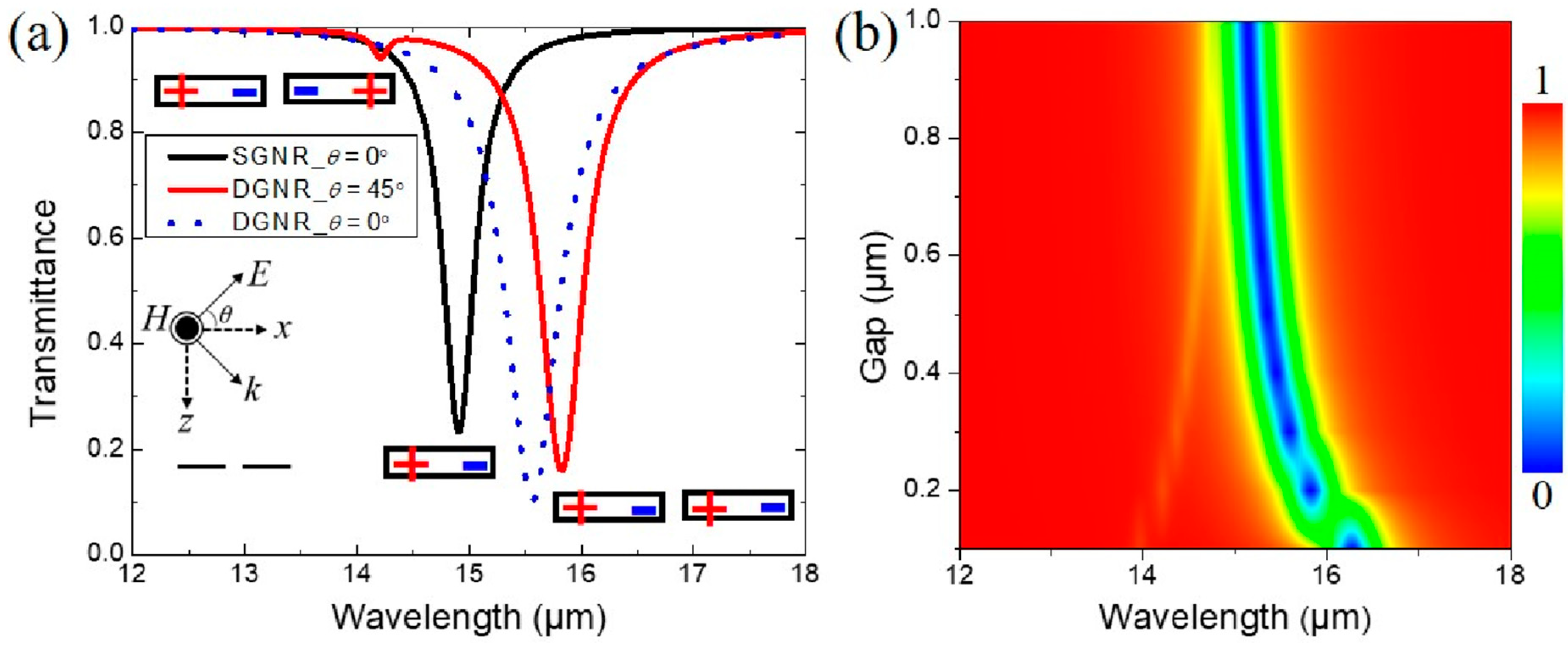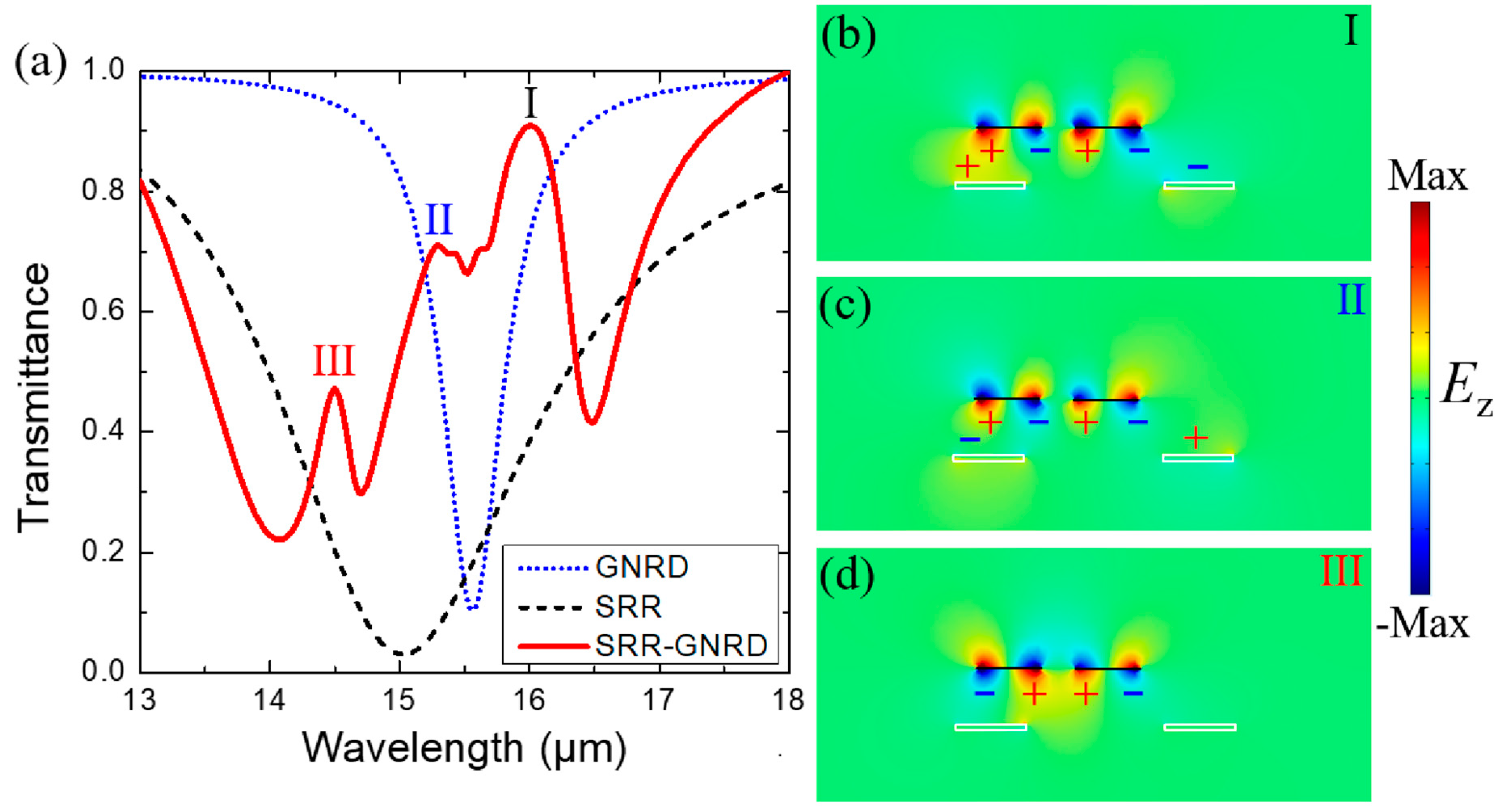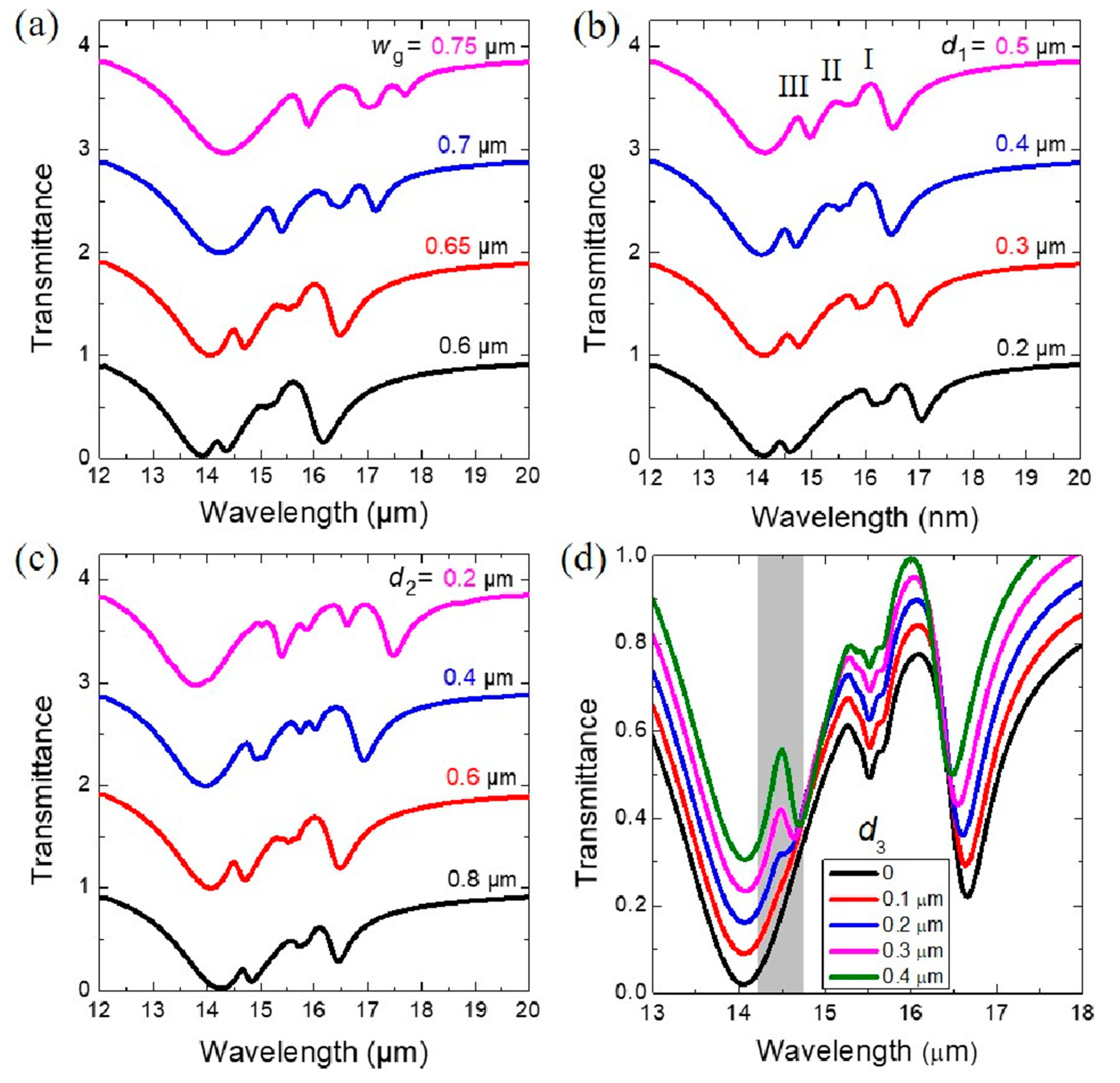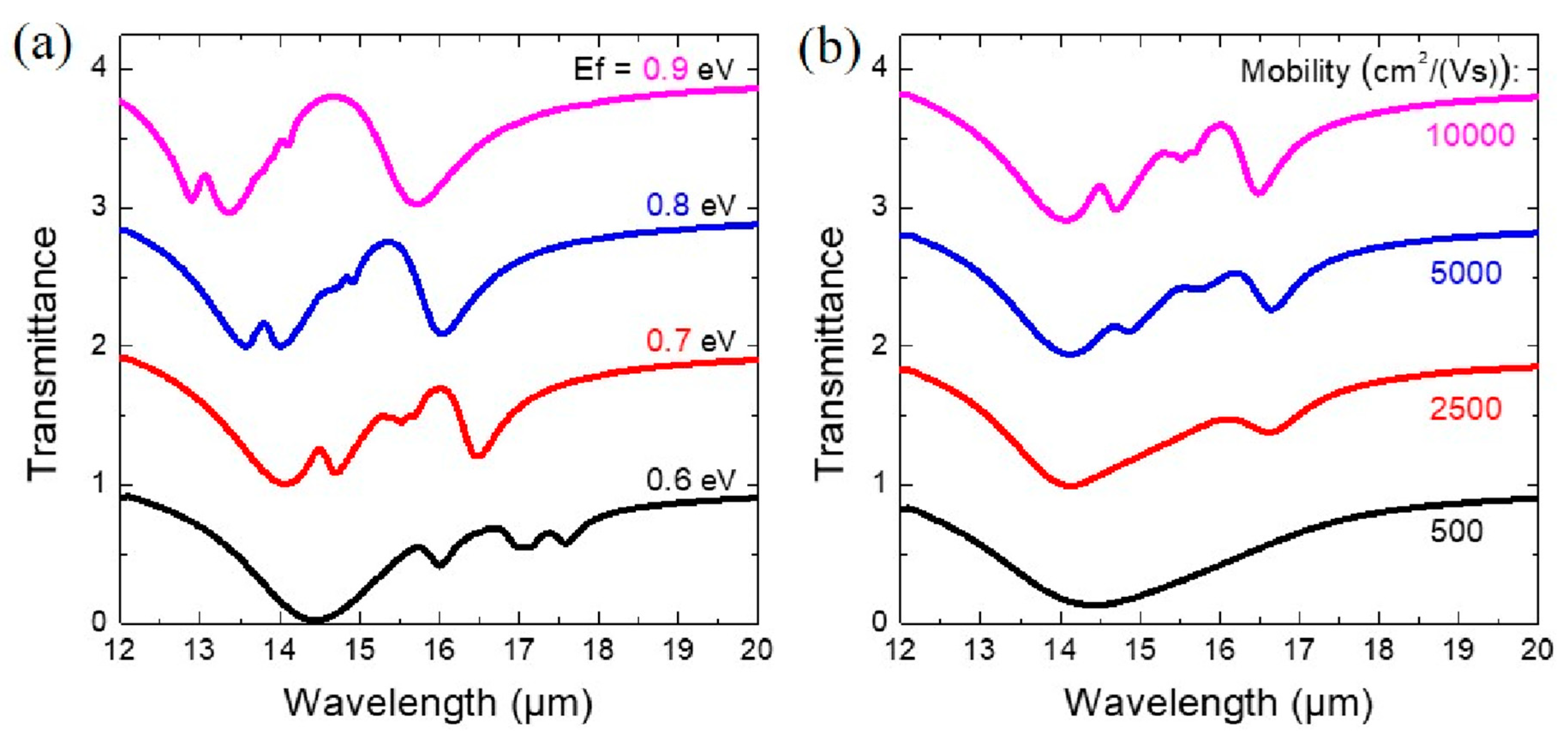Graphene Multiple Fano Resonances Based on Asymmetric Hybrid Metamaterial
Abstract
1. Introduction
2. Methods
3. Results and Discussion
4. Conclusions
Supplementary Materials
Author Contributions
Funding
Conflicts of Interest
References
- Luk’yanchuk, B.; Zheludev, N.I.; Maier, S.A.; Halas, N.J.; Nordlander, P.; Giessen, H.; Chong, C.T. The Fano resonance in plasmonic nanostructures and metamaterials. Nat. Mater. 2010, 9, 707. [Google Scholar] [CrossRef]
- Chen, J.; Mao, P.; Xu, R.; Tang, C.; Liu, Y.; Wang, Q.; Zhang, L. Strategy for realizing magnetic field enhancement based on diffraction coupling of magnetic plasmon resonances in embedded metamaterials. Opt. Express 2015, 23, 16238. [Google Scholar] [CrossRef]
- Zhang, C.; Kang, G.; Xiong, Y.; Xu, T.; Gu, L.; Gan, X.; Pan, Y.; Qu, J. Photonic thermometer with a sub-millikelvin resolution and broad temperature range by waveguide-microring Fano resonance. Opt. Express 2020, 28, 12599. [Google Scholar] [CrossRef]
- Fan, J.A.; Wu, C.; Bao, K.; Bao, J.; Bardhan, R.; Halas, N.J.; Manoharan, V.N.; Nordlander, P.; Shvets, G.; Capasso, F. Self-assembled plasmonic nanoparticle clusters. Science 2010, 328, 1135. [Google Scholar] [CrossRef]
- Yan, Z.D.; Gu, P.; Bao, W.; Du, W.; Chen, Z.; Wang, Z. Robust Plasmonic Fano Resonances in π-Shaped Nanostructures. Plasmonics 2015, 10, 1159. [Google Scholar] [CrossRef]
- Tang, C.; Zhan, P.; Cao, Z.; Pan, J.; Chen, Z.; Wang, Z.L. Magnetic field enhancement at optical frequencies through diffraction coupling of magnetic plasmon resonances in metamaterials. Phys. Rev. B 2011, 83, 041402. [Google Scholar] [CrossRef]
- Ye, J.; Wen, F.; Sobhani, H.; Lassiter, J.B.; Van Dorpe, P.; Nordlander, P.; Halas, N.J. Plasmonic nanoclusters: Near field properties of the Fano resonance interrogated with SERS. Nano Lett. 2012, 12, 1660. [Google Scholar] [CrossRef]
- Wang, W.S.; Lassiter, J.B.; Swanglap, P.; Sobhani, H.; Khatua, S.; Nordlander, P.; Halas, N.J.; Link, S.A. Plasmonic Fano switch. Nano Lett. 2012, 12, 4977. [Google Scholar]
- Papasimakis, N.; Zheludev, N.I. Metamaterial-induced transparency: Sharp Fano resonances and slow light. Opt. Photonics News 2019, 20, 22. [Google Scholar] [CrossRef]
- He, Z.; Xue, W.; Cui, W.; Li, C.; Li, Z.; Pu, L.; Feng, J.; Wang, X.; Gang, L. Tunable Fano Resonance and Enhanced Sensing in a Simple Au/TiO2 Hybrid Metasurface. Nanomaterials 2020, 10, 687. [Google Scholar] [CrossRef]
- Qin, M.; Wang, L.; Zhai, X.; Chen, D.C.; Xia, S.X. Generating and Manipulating High Quality Factors of Fano Resonance in Nanoring Resonator by Stacking a Half Nanoring. Nanoscale Res. Lett. 2017, 12, 578. [Google Scholar] [CrossRef]
- Chen, J.; Xu, R.; Mao, P.; Zhang, Y.; Liu, Y.; Tang, C.; Liu, J.; Chen, T. Robust label-free biosensing using microdisk laser arrays with on-chip references. Opt. Express 2013, 26, 3161. [Google Scholar] [CrossRef]
- Wondimu, S.F.; Hippler, M.; Hussal, M.; Hofmann, A.; Krämmer, S.; Lahann, J.; Kalt, H.; Freude, W.; Koos, C. Engineering the magnetic plasmon resonances of metamaterials for high-quality sensing. Opt. Express 2017, 25, 3675. [Google Scholar]
- Yi, Z.; Li, X.; Xu, X.; Chen, X.; Ye, X.; Yi, Y.; Duan, T.; Tang, Y.; Liu, J.; Yi, Y. Nanostrip-Induced High Tunability Multipolar Fano Resonances in a Au Ring-Strip Nanosystem. Nanomaterials 2018, 8, 568. [Google Scholar] [CrossRef]
- Muhammad, N.; Khan, A.D.; Deng, Z.L.; Khan, K.; Yadav, A.; Liu, Q.; Ouyang, Z. Plasmonic Spectral Splitting in Ring/Rod Metasurface. Nanomaterials 2017, 7, 568. [Google Scholar] [CrossRef]
- Manjappa, M.; Srivastava, Y.K.; Cong, L.; Al-Naib, I.; Singh, R. Active photoswitching of sharp Fano resonances in THz metadevices. Adv. Mater. 2017, 29, 1603355. [Google Scholar] [CrossRef]
- Si, G.; Zhao, Y.; Leong, E.S.P.; Liu, Y.J. Liquid-crystal-enabled active plasmonics: A review. Materials 2014, 7, 1296. [Google Scholar] [CrossRef]
- Hosseini, P.; Wright, C.D.; Bhaskaran, H. An optoelectronic framework enabled by low-dimensional phase-change films. Nature 2014, 511, 206. [Google Scholar] [CrossRef]
- Huang, Z.; Lu, H.; Xiong, H.; Li, Y.; Chen, H.; Qiu, W.; Guan, H.; Dong, J.; Zhu, W.; Yu, J.; et al. Fano Resonance on Nanostructured Lithium Niobate for Highly Efficient and Tunable Second Harmonic Generation. Nanomaterials 2019, 9, 69. [Google Scholar] [CrossRef]
- Owiti, E.O.; Yang, H.N.; Liu, P.; Ominde, C.F.; Sun, X.D. Polarization Converter with Controllable Birefringence Based on Hybrid All-Dielectric-Graphene Metasurface. Nanoscale Res. Lett. 2018, 13, 38. [Google Scholar] [CrossRef]
- Jablan, M.; Buljan, H.; Soljačić, M. Plasmonics in graphene at infrared frequencies. Phys. Rev. B 2009, 80, 245435. [Google Scholar] [CrossRef]
- Liu, B.; Tang, C.J.; Chen, J.; Wang, Q.; Pei, M.; Tang, H. Dual-band light absorption enhancement of monolayer graphene from surface plasmon polaritons and magnetic dipole resonances in metamaterials. Opt. Express 2017, 25, 12061. [Google Scholar] [CrossRef]
- Amin, M.; Farhat, M.; Baǧcı, H. A dynamically reconfigurable Fano metamaterial through graphene tuning for switching and sensing applications. Sci. Rep. 2013, 3, 2105. [Google Scholar] [CrossRef]
- He, X.; Lin, F.; Liu, F.; Shi, W. Terahertz tunable graphene Fano resonance. Nanotechnology 2016, 7, 12682. [Google Scholar] [CrossRef]
- Huang, Z.; Dai, Y.; Su, N.; Yan, Z.; Zhan, P.; Liu, F.; Wang, Z. Dynamically Tunable Electromagnetically Induced Transparency in Graphene and Split-Ring Hybrid Metamaterial. Plasmonics 2018, 13, 451. [Google Scholar] [CrossRef]
- Zhou, J.; Yan, S.; Li, C.; Zhu, J.; Liu, Q.H. Perfect ultraviolet absorption in graphene using the magnetic resonance of an all-dielectric nanostructure. Opt. Express 2018, 26, 18155. [Google Scholar] [CrossRef]
- Guo, X.; Hu, H.; Zhu, X.; Yang, X.; Dai, Q. Higher order Fano graphene metamaterials for nanoscale optical sensing. Nanoscale 2017, 9, 14998. [Google Scholar] [CrossRef]
- Choudhary, K.; Adhikari, K.; Biswas, A.; Ghosal, A.K.; Bandyopadhyay, A. Fano resonance due to discrete breather in nonlinear Klein–Gordon lattice in metamaterials. J. Opt. Soc. Am. B 2012, 29, 2414. [Google Scholar] [CrossRef]
- Yan, Z.D.; Gu, P.; Pu, X.; Huang, Z.; Chen, J.; Tang, C.J.; Yu, Z. Graphene hybridized ultrahigh-Q high-order Fano resonance for nanoscale optical sensing. Appl. Phys. Express 2020, 13, 2. [Google Scholar] [CrossRef]
- Ren, J.; Wang, G.; Qiu, W.; Lin, Z.; Chen, H.; Qiu, P.; Wang, J.X.; Kan, Q.; Pan, J.Q. Optimization of the Fano Resonance Lineshape Based on Graphene Plasmonic Hexamer in Mid-Infrared Frequencies. Nanomaterials 2017, 7, 238. [Google Scholar] [CrossRef]
- Zhou, H.; Su, S.; Qiu, W.; Zhao, Z.; Lin, Z.; Qiu, P.; Kan, Q. Multiple Fano Resonances with Tunable Electromagnetic Properties in Graphene Plasmonic Metamolecules. Nanomaterials 2020, 10, 236. [Google Scholar] [CrossRef]
- Zhang, Y.; Li, T.; Zeng, B.; Zhang, H.; Lv, H.; Huang, X.; Zhang, W.; Azad, A.K. A graphene based tunable terahertz sensor with double Fano resonances. Nanoscale 2015, 7, 12682. [Google Scholar] [CrossRef]
- Liu, N.; Guo, H.; Fu, L.; Kaiser, S.; Schweizer, H.; Giessen, H. Plasmon hybridization in stacked cut-wire metamaterials. Adv. Mater. 2007, 19, 3628. [Google Scholar] [CrossRef]
- Dai, Y.; Chen, A.; Xia, A.; Han, D.; Liu, X.; Shi, L.; Zi, J. Symmetry breaking induced excitations of dark plasmonic modes in multilayer graphene ribbons. Opt. Express 2016, 24, 20021. [Google Scholar] [CrossRef]
- Liu, Z.; Liu, G.; Liu, X.; Huang, S.; Wang, Y.; Pan, P.; Liu, M. Achieving an ultra-narrow multiband light absorption meta-surface via coupling with an optical cavity. Nanotechnology 2015, 26, 235702. [Google Scholar] [CrossRef]
- Yan, Z.D.; Qian, L.; Zhan, P.; Wang, Z. Generation of tunable double Fano resonances by plasmon hybridization in graphene–metal metamaterial. Appl. Phys. Express 2018, 11, 7. [Google Scholar] [CrossRef]
- Liu, N.; Liu, H.; Zhu, S.; Giessen, H. Stereometamaterials. Nat. Photonics 2009, 3, 157. [Google Scholar] [CrossRef]
- Prodan, E.; Radloff, C.; Halas, N.J.; Nordlander, P. A hybridization model for the plasmon response of complex nanostructures. Science 2003, 302, 419. [Google Scholar] [CrossRef]
- Ding, J.; Arigong, B.; Ren, H.; Shao, J.; Zhou, M.; Lin, Y.; Zhang, H. Dynamically Tunable Fano Metamaterials through the Coupling of Graphene Grating and Square Closed Ring Resonator. Plasmonics 2015, 10, 1833. [Google Scholar] [CrossRef]





Publisher’s Note: MDPI stays neutral with regard to jurisdictional claims in published maps and institutional affiliations. |
© 2020 by the authors. Licensee MDPI, Basel, Switzerland. This article is an open access article distributed under the terms and conditions of the Creative Commons Attribution (CC BY) license (http://creativecommons.org/licenses/by/4.0/).
Share and Cite
Yan, Z.; Zhang, Z.; Du, W.; Wu, W.; Hu, T.; Yu, Z.; Gu, P.; Chen, J.; Tang, C. Graphene Multiple Fano Resonances Based on Asymmetric Hybrid Metamaterial. Nanomaterials 2020, 10, 2408. https://doi.org/10.3390/nano10122408
Yan Z, Zhang Z, Du W, Wu W, Hu T, Yu Z, Gu P, Chen J, Tang C. Graphene Multiple Fano Resonances Based on Asymmetric Hybrid Metamaterial. Nanomaterials. 2020; 10(12):2408. https://doi.org/10.3390/nano10122408
Chicago/Turabian StyleYan, Zhendong, Zhixing Zhang, Wei Du, Wenjuan Wu, Taoping Hu, Zi Yu, Ping Gu, Jing Chen, and Chaojun Tang. 2020. "Graphene Multiple Fano Resonances Based on Asymmetric Hybrid Metamaterial" Nanomaterials 10, no. 12: 2408. https://doi.org/10.3390/nano10122408
APA StyleYan, Z., Zhang, Z., Du, W., Wu, W., Hu, T., Yu, Z., Gu, P., Chen, J., & Tang, C. (2020). Graphene Multiple Fano Resonances Based on Asymmetric Hybrid Metamaterial. Nanomaterials, 10(12), 2408. https://doi.org/10.3390/nano10122408




